Traditionally Professional Courtesy is something that physicians gave each other - but we had to be careful with it when…
Monday Morning Update 9/29/14
Top News
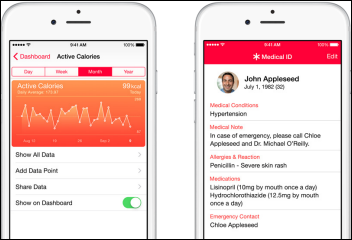
Apple’s HealthKit health data aggregation system and the apps that use it go live after being pulled previously from the initial iOS 8 rollout due to unspecified bugs. Some HealthKit-powered apps that are back in the App Store after the iOS 8.0.2 update are FitPort, MyFitnessPal, WebMD for iPhone, and Carrot Fit. HealthKit allows iPhone-collected fitness measures to be forwarded to other iPhone apps, brokering the exchange using the phone owner’s permissions of allowable data sources and destinations. That might be the most significant aspect of HealthKit – the consumer-patient is in charge of the collection and movement of information about them.
Reader Comments

From Ben and Jerry: “Re: Chuck Podesta. Gone from Fletcher Allen, now CIO of UC Irvine Health.” Verified per his LinkedIn profile.
From WisconsinBeerGut: “Re: Epic to Cerner conversions. I’ve worked for Epic and consulting companies and I’m not aware of any clients that have replaced Epic. Some mergers to watch that involved Epic and non-Epic users are NorthShore-Advocate in Illinois and UAHN-Banner in Arizona.” Given Epic’s cost, you’d have to really hate it to contemplate spending money to replace it. That’s not the only reason that it keeps users, but it may be significant one.
From Ex-Epic: “Re: Cernover. Judy prides herself on the fact that Epic has never lost a customer to Cerner or any other vendor. There have been some small scale de-installs for various reasons unrelated to dissatisfaction with Epic and those of course get swept under the rug, but to my knowledge (and according to Judy) there has never been an Epic to Cerner move.”
From AtUGM: “Re: Epic’s app exchange announced at UGM. It envisions that hospitals will sell their self-developed apps. My organization has discussed this with Epic, but Epic hasn’t provided any way to do it other than as a spin-off, which we’re loath to do. Eclipsys had an app exchange and I don’t think it went anywhere. It would be great if you wrote a feature discussing these app development opportunities with the big companies and what it would take to actually be useful to those of us in the industry.” I assume that vendor-specific app stores work like Apple’s – the vendor skims 20-30 percent off the top and sells apps that meet their published requirements. I would be interest in hearing about anyone who’s actually bought an app from a healthcare IT vendor’s store. I would be worried about paying a lot for something that might be poorly supported or that won’t be enhanced regularly.
HIStalk Announcements and Requests
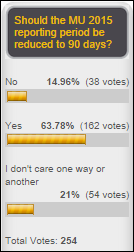
Most poll respondents like the idea of a 90-day MU reporting period for 2015 instead of the 365-day version that is official for the moment. New poll to your right or here: is it OK for an EHR vendor to block system access to a late-paying practice or hospital? Leave a comment after voting with your thoughts.
Last Week’s Most Interesting News
- Intermountain Healthcare joins the Cerner-Leidos-Accenture DoD EHR bidding consortium.
- Hospital operator HCA announces its intent to acquire physician systems vendor PatientKeeper, signaling that it will remain a Meditech clinical system customer.
- A government report exposes HHS-CMS infighting and incompetence as Healthcare.gov went down in flames at its launch last October.
- ZirMed acquires predictive analytics vendor MethodCare.
- ONC Chief Science Officer Doug Fridsma, MD, PhD resigns to become president and CEO of AMIA.
Acquisitions, Funding, Business, and Stock
Oncology data vendor COTA closes $3.7 million of a planned $7 million funding round. Most of the folks involved are from Hackensack University Medical Center’s cancer center.
Meditech finally issues its 2013 annual report that was due 11 months ago but was held up following revenue recognition changes. Revenue was down a bit from 2012 at $580 million, but net income rose to $133 million (that’s an enviable margin). Neil Pappalardo owns nearly 41 percent of the company, or about $680 million worth. The directors and officers of the company have been around forever, with the newest hires among their ranks having joined the company 24 years ago.
People

FCC Director of Health Initiatives Matt Quinn leaves the agency for a job with Intel.
Announcements and Implementations

CareSync announces version 2.5 of its personal medical records system, which adds the ability to collect and track information from 80 health and fitness apps such as Fitbit and Withings blood pressure cuffs.
CVS Health announces new MinuteClinic affiliations with University of Maryland Medical System, UTMB, and UAB.
Government and Politics
An investigation finds that HHS paid WebMD $14 million to promote the Affordable Care Act.
Glucose monitor manufacturers and the FDA express concern that the technologically sophisticated family members of diabetes patients are hacking the devices to make them more useful, partially because FDA takes forever to approve manufacturer-requested changes. A group of engineers, many of them parents of diabetic children, modified a glucose monitor to send readings to a website so that parents can monitor their children who are away on sleepovers.
A Premier study of ACOs finds that while most are improving care using basic internal systems such as EHRs, patient registries, and data warehouses, they struggle with bringing in data from external sources and providing patient-facing technologies. The key obstacles are interoperability problems and cost.
Penn Medicine (PA) has developed 75 apps, including the MedView physician portal and new Connexus patient data display app.
Weird News Andy provides a non-weird item: US hospitals aren’t prepared to handle Ebola-related patient waste since no disposal packaging has been approved, causing waste management companies to refuse to accept it. Emory University Hospital finally convinced Stericycle to accept 40 bags of infectious waste by first autoclaving it, but only after CDC brokered a deal.
Death rates dropped at two English hospitals that moved from paper-based vital signs charting to using the VitalPAC electronic system that provides warnings when patients are deteriorating. The hospitals developed the “early warning score” software with a vendor.
Here’s the more traditionally odd Weird News Andy article, which he titles “Give It a Shot.” The state nurse’s union sues Brigham and Women’s Hospital for requiring employees to get a flu shot after voluntary efforts failed to move the needle (pun intended) above 77 percent participation vs. 90 percent success in peer hospitals. State law prohibits hospitals from requiring employees to get a flu shot even though several hospitals require it as a condition of employment.
Healthcare Analytics Summit 14 Report

I attended Health Catalyst’s Healthcare Analytics Summit 14 last week, my first visit to Salt Lake City. Note: in the interests of disclosure, the company comped my registration fee although I paid my own expenses otherwise. I took the photo above from my room’s balcony, by the way – a very brief rain shower kicked up on a sunny afternoon and created a double rainbow over the City-County Building.
The Health Catalyst folks were hoping for around 100 attendees and ended up with 500. The event was held in a beautiful five-star hotel, the Grand America, which had surprisingly reasonable prices and outstanding service. Rooms, food, and meeting facilities were excellent.
Salt Lake City apparently is not quite as Mormon Church-driven as I naively expected since you can actually get ethnic food and alcoholic beverages, although some odd rules are in place (as explained to me, you can’t order drinks without buying food, so you pay $2 for a bowl of peanuts to allow you to order a beer). Good restaurants were an easy walk away, everything from tapas to tacos (my choices: Green Pig Tavern, Eva, Himalayan Kitchen, Caffe Molise, and Tin Angel Cafe). It’s a lot smaller city than I would have guessed – around 200,000 residents – and the mountains create an attractive backdrop. I checked out a rehearsal of the Mormon Tabernacle Choir that was inspiring. The weather was a lot hotter than I expected. My overall impression of the city was favorable, although since I don’t ski, I’m not sure I would have a non-business reason to return.

The event logistics were unparalleled. Plenty of Health Catalyst folks were on hand to direct people, answer questions, and even run a Genius Bar-type setup to help attendees use the cool app developed for the conference, which allowed interactive voting, reacting to speakers, and connecting with fellow attendees. I happened to chat with the guy whose company developed the app while walking to a session and he said it was built specifically for this conference. If it can scale, it would be pretty cool for larger conferences as well.
Presenters included Glenn Steele, Jr. MD, PhD, president and CEO of Geisinger Health System; James Merlino, MD, chief experience officer, Cleveland Clinic; Mike Leavitt, former Utah governor and former HHS secretary; Ray Kurzweil, director of engineering, Google; Penny Ann Wheeler, MD, president and chief clinical officer, Allina Health; and Charles Macias, MD, MPH, chief clinical systems integration officer, Texas Children’s Hospital.
A bizarre press restriction prevents me from even mentioning the name of the keynote speaker, although you can see it here. That’s too bad because I would have gushed about how entertaining and surprisingly relevant he was, and my fellow attendees seemed to agree given their highest rating of his keynote from all of the first day’s sessions. It was a bold choice by Health Catalyst. I enjoyed his talk more than any keynote I’ve ever heard. He would make an outstanding HIMSS keynote presenter, much better than the drones they’ve propped up on stage lately.
My least-favorite speaker was Mike Leavitt, who always struck me as a lightweight political journeyman turned opportunistic lobbyist. He rambled and misspoke to the point that I was checking email for most of his presentation. Everybody else did a great job, although I might have dialed back the presence of Health Catalyst people on the podium a bit if the intention was to engage attendees who don’t necessarily have a Health Catalyst connection. It got a bit confusing since three of the folks involved are from the same family (Burton) and were introduced with both past and present titles as the company made changes over the years, so I couldn’t keep track of who’s who as they came and went from the podium over the two days. I didn’t get a whole lot from the three breakout sessions, so for me the value was in the keynotes.
Health Catalyst used information collected from the app to announce some interesting (and sometimes creepy) facts gleaned from audience responses, such as that Android users were most likely to blow off the breakout sessions after attending the keynotes. Every session included several instant poll audience questions and a team of analysts presented the results immediately as the presenter paused. That was pretty cool and a nice touch to connect presenters with the audience.
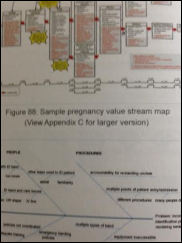
I should also note that this was neither a user group meeting nor a selling opportunity. The presenters for the most part were vendor-neutral and talked about using data in general, not Health Catalyst’s products in particular. I also applaud the company for really thorough preparation right down to the minor points of quality of the handouts, stage setup, and food and break logistics. Also a high point was distribution of an internally written book that I’ll be reading cover to cover. They really have a lot of good information to share that transcends their products alone.
Some of the memorable points of the conference from my perspective:
- It’s clear that the hasty move to electronic medical records and health apps is creating more data than anyone understands. We’re at the exploratory stage, trying to figure out which of thousands of data points are relevant in predicting outcomes or triggering interventions. This is exciting. We are surrounded by data that we don’t yet know what to do with, but the first glimmers of success are coming out.
- A lot of people, including many of healthcare’s leaders, aren’t convinced that the industry should be data driven. Not only does the “medicine as an art vs. a science” argument arise, but leaders often have personality types that value bold decisions based on emotion, history, gut instinct, leading through relationships, and valuing consensus over facts. As was said several times in the conference, it takes courage to use data, especially when it tells us something we don’t want to hear or that requires unsavory actions.
- Becoming a data-driven organization requires two attributes. The first is fairly simple from the non-IT point of view – collecting and analyzing the information. The second is having the organizational willpower to do something with it. Facts alone don’t change anything – leadership is required.
- Better care costs less. Analysis nearly always shows that the highest-cost organizations deliver lower-quality care. The upside of this is that we can improve care and outcomes without spending a penny more than we already do as a society, provided we have the will to do it.
- As the unnamed keynote speaker pointed out, people mimic those who are having success. The organizations improving care and reducing cost through the use of data will find their competitors raising the bar by doing the same. Nobody wants to be in the higher percentiles of cost or the lower percentiles of quality, so as competitors eye each other warily, it’s likely that they will raise the boats for everyone.
- Everybody has a data warehouse. Most of them don’t provide useful information.
- You can’t selectively intervene on individual patients by using claims data. By the time you take action, the high-cost patients have costs trending back down and you’ve missed the opportunity.
- People seem to love QlikView as a data analysis and presentation tool. I noticed several presenters from provider organizations were using QlikView dashboards.
- An interesting thought from one presenter: “We don’t take a quality assurance or compliance approach.” In other words, it’s not effective to chase the 2.5 percent of outlier providers. Instead, move the 80 percent even higher since improving the already-good majority has a much greater overall impact.
- The maturity progressions looks like this: data reporting –> data analysis –> decision support –> predictive analytics.
- “Predictive analytics without actions an interventions are useless.” You can predict things you don’t care about or are reluctant to act on.
- The most relevant health factors involve socioeconomics. Healthcare delivery organizations can’t fix those.
- The wisdom of crowds still has value even in an analytics-driven organization.
I give this conference a high grade. The logistics were superb, the size and scope was just right, the value was significant, and the speakers were well chosen and interesting.
Contacts
Mr. H, Lorre, Jennifer, Dr. Jayne, Dr. Gregg, Lt. Dan, Dr. Travis.
More news: HIStalk Practice, HIStalk Connect.
Get HIStalk updates.
Contact us online.



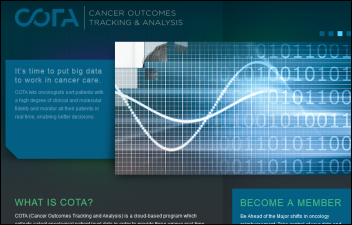
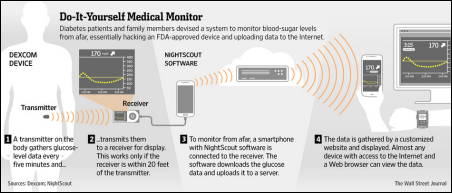
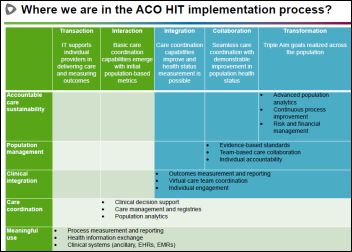
Billy Beane! I agree that was an inspired choice for a speaker. Someone who has actually used data to change an entire industry!
Apple Medical ID: I entered my info on my iPhone….so do I have this straight–text-entered med list only? No link to drug database, pharmacy, pharmacy benefit provider, anything?
Just saw the HIMSS15 keynote announcement and I’m already wondering how they’ll approach threading healthcare into “thoughts on eight years in the Oval Office, the challenges facing our nation in the 21st century, the power of freedom, the role of faith and other pressing issues.” Hearing from a former president is great, but I’m hoping that’s not a politically divisive mess. Where’s Billy Beane when you need him?